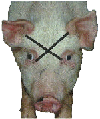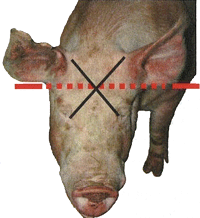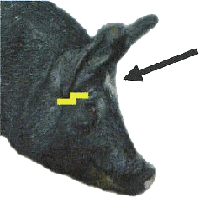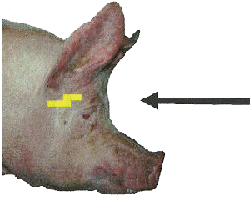Guidelines for Stunning Techniques of Mammalian Food Animals
2. Swine (hogs, sows, boars, wild boar)
2.1 Mechanical
Important factors:
- Handling and restraint facilities must promote good animal welfare standards.
- Pigs have small brains relative to the size of their head; therefore the target area is very small and may make stunning effectively more difficult.
- Sows and boars have very thick frontal bones in their skull which may make penetration of the bolt more difficult, so the power of the device must be adapted
- Note: There can be breed variation in head shape in mature animals. "Yorkshire" type animals (not necessarily a Yorkshire hog) have a prominent curvature in the front of their head; this "dish face" can also make it difficult to find the target area. (See [e] below.)
- Immature animals and mature animals with a straight front to their head can be stunned by holding the stunning device perpendicular to the front of their head. (See [d] below.)
- This approach may need to be modified in "Yorkshire" type animals with a pronounced curvature to the front of their head, or if an animal is stunned with a firearm. (See [e] below.)
- Plan the trajectory so the bolt or projectile travels through the brain (cerebral hemispheres, midbrain and brainstem) The most significant of these are the midbrain and brainstem which are located in the centre of the skull at the level of the bottom of the attachment of the ears (See [b], [c], [d] and [e] below.)
- Use precise landmarks. (See all below.)
2.1.1 Landmarks and approaches
2.1.1.1 Market Hog
Intersection of diagonal lines from the midpoint of the attachment of each ear to the medial canthus (middle corner) of the opposite eye. This is approximately 2 ½ cm or 1 in. above the eyes. (See [a] and [b] below.)
2.1.1.2 Sow or boar
Intersection of diagonal lines from the top of the attachment of each ear to the medial canthus (middle corner) of the opposite eye. (See [c] below.)
Note: Regardless of the entry point, the angle of the stunning device with the front of the head must result in a path of the bullet or bolt that will intersect with an internal line from the base of one ear to the other, running through the brain stem. (See [a], [b], [c], [d] and [e] below.)
Frontal View





Note: Breed and age effect on curvature of the front of the head in the side view. (See [d] and [e] above.)
| Image | Description |
|---|---|
 |
Level of the brainstem - in the middle of the skull. |
 |
Location of the brainstem and midbrain - in the middle of the skull. |
 |
Intersection of the diagonal lines indicates the entry point for the bolt or projectile of a mechanical stunning device held perpendicular to the front of the skull. |
 |
Trajectory of the projectile as it travels to the midbrain and brainstem. |
2.1.2 Mechanical Stunning Devices
2.1.2.1 Captive bolt
- Bolt length must be at least 12 cm (4 ¾ in.). Bolt length must be 15 cm (6 in.) for sows and boars.
- Calibres (diameter) available for the cartridge bolts include .22, .25 and .33.
- Larger bolt diameters (.25 and .33) are far more effective for larger animals.
- Use manufacturer's recommended charge, operation, cleaning and maintenance program.
- Assess bolt velocity by using the manufacturer's bolt velocity testing device, or similar means (daily).
- See 2.1.1, Landmarks and approaches, above.
| Animal | Calibre (options) | Bolt Lengths | Muzzle Velocity (ft/s) |
|---|---|---|---|
| Hogs | .22, .25, .33 | 12 cm (4 ¾ in.) | ≥ 55 m/s (183 ft/s) |
| Sows and Boars | .25, .33 | 15 cm (6 in.) | ≥ 72 m/s (236 ft/s) |
2.1.2.2 Firearms
- Use the slowest velocity and minimum energy (muzzle) required to effectively stun the animal.
- Planning the trajectory is particularly important if the stunner operator is shooting from a standing position on the ground.
- See 2.1.1, Landmarks and approaches, above.
| Animal | Calibre | Grain | Muzzle Velocity (ft/s) | Energy (ft/lb) |
|---|---|---|---|---|
| Hogs | .22 LR (long rifle)Table Note 1 | 40 | 1255 | 140 |
| Sows and Boars | .22 LR (long rifle)Table Note 1 | 40 | 1255 | 140 |
| Sows and Boars | .22 Winchester Magnum | 40 | 1910 | 324 |
Table Notes
- Table Note 1
-
Do not use hollow point.
| Animal | Calibre | Grain | Muzzle Velocity (ft/s) | Energy (ft/lb) |
|---|---|---|---|---|
| Very Large Boars | .30 Remington Carbine | 110 | 1990 | 967 |
| Animal | Gauge | Length | Slug | Muzzle Velocity (ft/s) | Energy (ft/lb) |
|---|---|---|---|---|---|
| Large Sows and Boars |
.410 | 2 1/2 in. | 1/5 oz (87 g) | 1830 | 651 |
| Large Sows and Boars |
.410 | 3 in. | ¼ oz (108 g) | 1800 | 788 |

2.2 Electrical
Important factors:
- Handling and restraint facilities must promote good animal welfare.
- Constant amperage and variable voltage is to be used. (See minimum values below.)
- Electrodes must be firmly applied and not moved during the stunning process.
- The application of automated electrodes must not injure the animals.
- Dampen the hog (mist or spray) to improve electrical conduction (do not use an excessive amounts).
2.2.1 Landmarks and approaches
2.2.1.1 Head-to-head
- Span the brain by placing the electrodes behind the eyes on each side of the head, or
- Span the brain by placing the electrodes just under the base of each ear, or
- Place the electrodes on the bony process of the skull behind each ear.
- Do not place the electrodes on the neck.
- Bleeding must start in less than 30 seconds.
- With high frequency (> 350 Hz), low amperage, head-only stunning bleeding must start within 15 seconds.
2.2.1.2 Head-to-body
Option #1: Place two electrodes on the head (see 2.2.1.1) and a third electrode behind the heart on the 4th rib. Current is first directed to the two head electrodes, which is followed by applying current to the head and chest electrodes.
Option #2: Place one electrode on the front of the skull, or on the bony process behind the ear (see 2.2.1.1) and place the second electrode behind the heart on the 4th rib. Current is applied head to chest.
| Animal | Amperage | Volts | Frequency | Time (sec) |
|---|---|---|---|---|
| Hogs (head only) | ≥ 1.25 | > 250-300 | 50-60 | 1-3 |
| Hogs (head to body) | Head: ≥ 1.25 | > 250-300 | 50-60 | 1-2 |
| Hogs (head to body) | Body: ≥ 1.30 | > 300 | 50-60 | 3 |
| Sows or Boars | ≥ 2.0 | > 300 | 50-60 | 3 |
Note: Other voltages, frequencies and times may be used if:
- the plant operator presents documentation by a recognized animal welfare specialist outlining the protocol and demonstrable evidence that the method(s) used are consistently effective and humane; or
- a trial period of stunning is undertaken; or
- the procedure consistently meets animal welfare stunning requirements; or
- amperage (current) stuns; therefore, use constant amperage and variable volts.
2.3 Controlled Atmospheric Stunning (CAS) (CO2 and Gas Mixtures)
Important Factors:
- Pre-stun handling stress has a significant impact on animal response during induction of anaesthesia.
- Induction with CAS can be highly stressful, especially for some genetic strains of hogs.
- Pre-existing pneumonia can prolong the induction of anaesthesia.
- Handling, restraint and stunning facilities must meet current World Organization for Animal Health (WOAH; founded as Office International des Épizooties (OIE)) and industry standards.
- Design and function of the lairage and pre-stun handling area are important to minimize prestun stress in animals, which minimizes stress during the induction of anaesthesia.
- Gas stunner design and operation play an important role in minimizing stress during the induction of anaesthesia.
- Exposure time to the gas and the time between stunning and bleeding are important to ensure there is no return to sensibility before death. (See the stun-to-stick interval chart below.)
- The bleeding rail length is critical. There must be sufficient room to accommodate and stick stunned animals exiting the gas chamber during a kill line stoppage.
- Prior to installation of the CAS, planning must include provisions for possible increased line speeds.
- Stocking density of the chamber must be optimal: pigs must be able to stand without being on top of one another.
- Monitoring during pre-stun handling, induction of anaesthesia, sticking and bleeding is critical.
- Induction must be monitored by means of a camera or observation portal. Monitoring must occur at start up, after breaks in production and for a group of hogs differing in size or age from previous groups, for example, from different producers. More frequent monitoring may be required if there are problems with induction.
- Gas concentrations, startup gas mixing procedures and stunning procedures must conform to the manufacturer's recommendations. For alternate procedures see below.
- A maximum stun to stick interval must be validated.
- If hogs regain sensibility the gas concentration, and /or exposure time (to the highest concentration of gas), must be increased until all animals are properly stunned. (Backup mechanical stunners must be available and used when needed.)
- Example guidelines. Note: these times will vary with the system, genetic of hogs, etc. Monitoring return to sensibility is required. Time of exposure to the gas and stun to stick time must be adjusted if animals are returning to sensibility.
| First Stop 70-80% CO2 Total Time of Exposure [dwell time] (sec) |
Second Stop > 90% CO2 Stick within (sec) |
|---|---|
| 120 | 30 |
| 130 | 45 |
| 140 | 60 |
| 150 | 75 |
| 160 | 90 |
Note: Time is counted from last stop just before exiting the gondola.
2.3.1 Carbon dioxide (CO2) and Gas Mixtures
Concentration
- It is an WOAH requirement that no less than 80% concentration of CO2 be used (90% is preferable).
- Exposure time to the gases must be sufficient to ensure no pigs regain sensibility before death occurs due to cardiac arrest or bleeding.
- Stun to stick interval must be as per the stun-to-stick interval chart. (Shorter time frames may be required if there are return to sensibility problems.)
- Stunning
- The gas mixture and induction of anaesthesia must be non-aversive and must not be distressing.
- The chamber and methods of conveyance through it must avoid stress to the animals.
- The density of animals in the gondola must be such that animals do not fall or lay on each other during the stunning operation.
- The chamber must be lit.
- The chamber must be designed so that the animals in the chamber can be monitored at all times by direct observation ports, cameras, or similar means.
- The chamber must be equipped to continuously measure and display the CO2 concentration (or other gas used in the stunning process) at the point of induction and the maximum concentration.
- The system must provide visible and audible warnings if the gas concentration falls below the required levels.
- Stunning must be as per the manufacturer's stunning protocol. See below for alternate stunning procedures. Pigs usually require 3 minute exposure time to the concentrations indicated below.
| Type | Method of Stunning | Gas(es) | Concentration | Other Gases |
|---|---|---|---|---|
| CO2 | High blood levels of CO2 (Hypercapnia) | CO2 | ≥ 80% 90% (preferred) |
oxygen, nitrogen, etc. |
| Gas Mixtures |
Low blood levels of O2 (Hypoxia) | O2 | ≤ 2% (O2) | carbon dioxide, argon, nitrogen |
| Gas Mixtures |
Low blood levels of O2 and High blood levels of CO2 |
O2, and CO2 | ≤ 2% (O2) ≤ 30% (CO2) |
argon, nitrogen, etc. |
Note: Other gas mixtures and concentrations may be used if:
- The plant operator presents documentation by a recognized animal welfare specialist outlining the protocol and demonstrable evidence that the method(s) used are consistently effective and humane.
- A trial period of CAS stunning is not undertaken.
- The procedure consistently meets CAS animal welfare stunning requirements.
- Date modified: